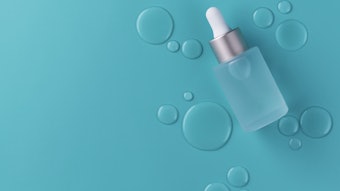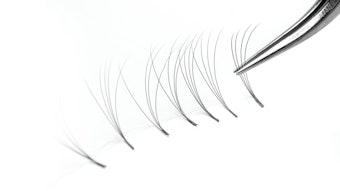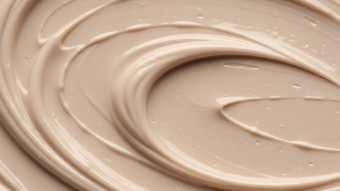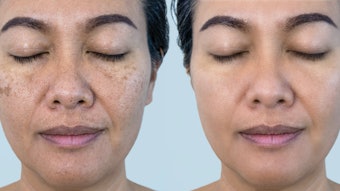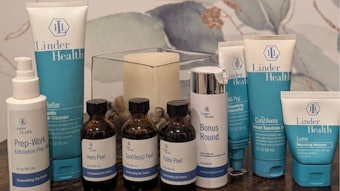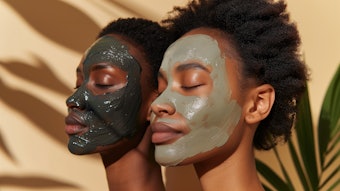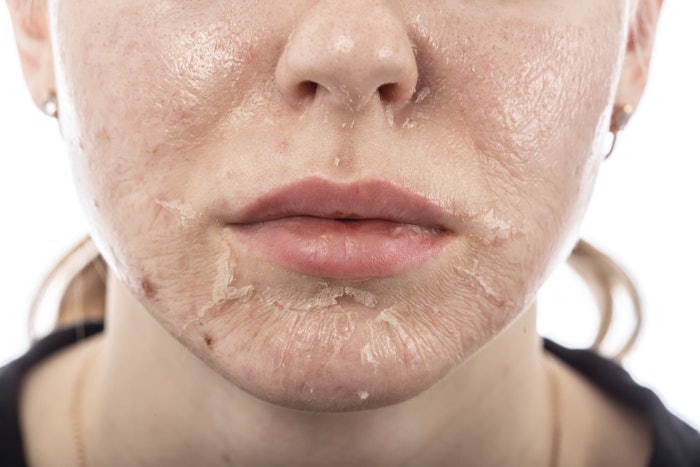
Chemical peels have been a cornerstone of professional skin care, offering results that range from a subtle glow to dramatic rejuvenation.
This article is only available to registered users.
Log In to View the Full Article
Chemical peels have been a cornerstone of professional skin care, offering results that range from a subtle glow to dramatic rejuvenation.
Mastering chemical peels involves more than just applying acids to the face. To peel like a pro, you must understand the science behind the treatment. Understanding acids, percentages, pH (potential of hydrogen) and pKa (acid dissociation constant) will help you choose the right formulations for your clients. Rather than just removing keratinized cells, the right chemical peel encourages the skin to heal in a more structured, youthful way. It enhances the rate of turnover while laying the groundwork for long-term improvements in tone, texture, clarity and resilience. When paired with proper pre- and post-care, chemical peels are not just for cosmetic correction, but for overall skin health.
Why Chemical Peels
Cellular turnover is a natural process during which dead skin cells are released from the stratum corneum of the epidermis and are replaced with new cells from the basal layer of the epidermis. In healthy skin, cells turn over approximately every 28 days until the age of 30, after which this natural exfoliation process decreases at an estimated rate of about ten days per decade.2 This decrease in the skin’s natural exfoliation can contribute to fine lines, wrinkles, acne, hyperpigmentation and a dull, dry appearance.
Chemical peels play a vital role in supporting and stimulating this process. By applying specific acids to the skin, we can break down protein structures that anchor cells to each other, known as desmosomes. That accelerates cell turnover, revealing fresher, healthier skin. An equally important function of exfoliation is to create a controlled wound response. When the skin responds to acute inflammation, it releases growth factors that trigger the production of new cells, including fibroblasts, to initiate the production of collagen and elastin. Stimulating the rate of skin exfoliation in a controlled manner can help reduce superficial imperfections while also promoting a healthier skin structure.
Types of Peels
Alpha Hydroxy Acids
There are six alpha hydroxy acids (AHAs) commonly used in skin care: glycolic, derived from sugar cane; lactic, from sour milk; malic, from apples; tartaric, from grapes; mandelic, from bitter almonds and citric, from fruit.
Glycolic acid is the most used AHA due to its small molecular size, which grants it a greater ability to penetrate the epidermis. The percentage (amount of acid in the product) for AHA peels typically ranges from 30% to 70% with a pH range of 2.0-3.5, although this can vary. Clients generally like the appearance of their skin following glycolic peels, although results may not be as significant as with other peeling agents. Multiple clinical studies have shown improvements in the appearance of the skin with the use of glycolic acid. It has also been shown to strengthen collagen, expanding its benefits for the skin.6
Lactic acid has properties similar to glycolic acid regarding its method of exfoliation; they are both water-soluble and dissolve bonds between keratinized cells. Lactic acid is commonly used on clients with more sensitive skin conditions, including rosacea, due to its larger molecular size, which makes it gentler than the smaller glycolic molecule. The added benefits of skin brightening and hydrating properties make lactic acid one of the most widely used exfoliants on the market, not only for in-office peels, but also in products for home use.
Mandelic acid is known for its gentle yet effective exfoliating properties. With a larger molecular structure than other AHAs like glycolic or lactic acid, mandelic acid penetrates the skin more slowly, making it an excellent choice for sensitive skin types or those prone to redness, inflammation or post-inflammatory hyperpigmentation (PIH). Mandelic acid also has antibacterial properties, making it beneficial for acne-prone skin, while its melanin-inhibiting effects can help fade hyperpigmentation. Mandelic acid is also often used in chemical peels for darker Fitzpatrick skin types, as it poses a lower risk of causing pigmentary changes.
Malic acid, citric acid and tartaric acid are also water-soluble ingredients with exfoliation properties. These acids are primarily used in blended peels due to their mild activity.
Beta Hydroxy Acid
Salicylic acid is a beta hydroxy acid (BHA) widely known as a superficial peeling agent with the ability to reduce acne. Salicylic acid can be synthetically produced or derived naturally from the bark of the willow tree and is chemically similar to the main component of aspirin (acetylsalicylic acid). Salicylic acid is lipid-soluble (attracted to oil) and has anti-inflammatory properties, which make it a top choice for oily, acne skin types. Salicylic acid is also used for the treatment of superficial pigmentation, warts, keratosis pilaris, psoriasis and calluses. Most salicylic acid formulations are safe for darker Fitzpatrick skin types, since they work on the superficial layers of skin, reducing the chance of hyperpigmentation. You should not treat clients who are allergic to aspirin, as they can have severe reactions to salicylic acid.
TCA Trichloroacetic Acid
Trichloroacetic acid (TCA) originated as a medium-depth chemical peeling treatment by medical professionals. TCA is a synthetic acid shown to be safe for use on the skin as a peeling agent with no systemic effects. TCA is an agent that coagulates skin protein. It should be used with caution, as it can penetrate the dermis. If used incorrectly, it can cause a bacterial infection, a herpes simplex breakout, pigment abnormalities and scarring. TCA is available in concentrations of up to 99%; however, the most used concentrations range from 10% to 30%. Higher percentage TCA peels should only be used by a physician.
Jessner’s Peel
A traditional Jessner’s peel is a combination of 14% resorcinol, 14% salicylic acid and 14% lactic acid in an alcohol base. Jessner’s, developed by Dr. Max Jessner, has been safely used for skin rejuvenation for more than a century. Many of the formulas used today are modified Jessner’s peels because they have been slightly altered. The Jessner’s peel was originally developed to reduce the effects of using only resorcinol (a keratolytic agent that has antibacterial properties) on the skin. The Jessner’s peel is most used for combination to oily skin that shows some degree of photo-damage. A Jessner's peel should not be performed on sensitive, dry skin types or those with rosacea, due to the peel's high alcohol content. This peel is most effective for hyperpigmentation, severe photo-damage, acne and oily conditions.
Blended Peels
Blended chemical peels combine two or more exfoliating agents, including AHAs, BHAs, retinoids and/or TCA to deliver synergistic results. By using different acids with complementary mechanisms of action, blended peels can target multiple skin concerns at once. For example, pairing salicylic acid with lactic acid allows for both deep pore cleansing and surface exfoliation with brightening in one treatment. Additionally, blended formulas often incorporate anti-inflammatory ingredients to buffer intensity, making them safer for sensitive skin and higher Fitzpatrick types. Many blended peels add beneficial ingredients, including pigment lighteners, vitamin C and/or hydrators. Blended peels allow estheticians to customize treatments precisely to the client’s needs.
Determining Peel Strengths
There are many things to consider when deciding to treat a client with a chemical peel, including the type of acid you'll use, its percentage and its pH. A peel's concentration depends on the percentage of acid in the solution; the greater this percentage, the stronger the acid concentration. On the other hand, chemicals with a lower pH are more acidic and can cause greater stimulation in the skin.
One often-overlooked aspect of chemical peels is the pKa value of each acid. pKa refers to the acid dissociation constant, which tells us how much of the acid is in its active form. This matters because the lower the pKa, relative to the pH of the peel solution, the stronger and more active the peel will be. For example, glycolic acid has a pKa of around 3.83. If you apply a glycolic peel with a pH of 2.5, that means a large percentage of the glycolic acid is in its active form, leading to more intense exfoliation. pKa is a constant number that doesn’t change. A lower pKa means the acid is more acidic, which allows for deeper, faster penetration. Understanding pKa helps professionals predict peel strength more accurately than percentage and pH alone. For instance, a TCA peel at a 0.7 pKa would be much stronger than a lactic acid peel at 3.86 pKa at the same percentage and pH.
| Acid | pKa |
| TCA | ~0.7 |
| Salicylic Acid | ~2.97 |
| Glycolic Acid | ~3.83 |
| Lactic Acid | ~3.86 |
| Mandelic Acid | ~3.41 |
| Resorcinol | ~9.3 |
Peel Depths
Levels of peeling vary, but most are categorized as either superficial peeling, which affects the outer layers of the epidermis, medium-depth peeling that can affect the papillary layer of the dermis, or deep peeling, which can reach the reticular layer of the dermis. Superficial peels have no downtime associated with them; if anything, they may cause flaking or mild perioral peeling. For best results, they are done in a series of six to twelve treatments spaced two to four weeks apart. They work well on all skin types, including sensitive skin and those with higher Fitzpatrick types.
Medium-depth peels should be performed under medical supervision. These peels involve some downtime. Initially, the skin feels tight, and discolorations may appear on the surface. A few days later, the skin starts to peel and can continue for up to ten days.
Deep peels, such as phenol and Baker’s Gordon, should only be performed by medical professionals as they can be dangerous. Phenol peels even require that patients be on a heart monitor. Deep peels can have up to six weeks of downtime and a high chance of complications, making them much less common today. Some risks include hyperpigmentation, hypopigmentation, scarring and a lasting, waxy appearance.
Factors that Affect How Skin Reacts to a Chemical Peel
1. The percentage of acid in the product
- The amount of acid in the peel
2. The pH of the product
- The acidity level of the peel
3. The type of acid(s) used
- Some acids are naturally stronger due to pKa
4. The amount of time left on the skin (for neutralized peels)
- The longer the peel is on, the stronger it becomes
5. The number of layers applied to the area (for leave-on peels)
- Delivers more acid and deepens penetration with each pass
6. The amount of product applied to a given surface area
- Various application methods deliver different amounts of acid
7. The condition of the skin before treatment
- Well-prepped skin will receive enhanced benefits
8. Product use by the client post- treatment
- Good support products will provide safe effective results
9. Client’s post-care compliance
- Getting excess heat or going in the sun can cause complications
10. Prepping solution
- The more degreased, the better the peel will penetrate
Prepping the Skin Prior to Peels
- The use of a mild keratolytic agent, such as glycolic acid (5% to 10%) or salicylic acid (2% to 5%) or mild retinols can increase the effectiveness of the peel. These should be discontinued three days before the peel to decrease the chance of side effects.
- Skin lightening agents should be used for a minimum of four weeks for those suffering from hyperpigmentation as well as darker skin types (Fitzpatrick IV-VI) to reduce the risk of PIH.
- The skin should be properly protected and hydrated; the use of a regular antioxidant, moisturizer and sunscreen will provide optimal results.
- Ingredients that support healing and regeneration will enhance the peel effects. Examples are hyaluronic acid, centella asiatica, peptides, growth factors, stem cells and exosomes.
Peeling like a pro goes far beyond simply applying acids; you need a solid foundation in skin anatomy, chemistry and treatment strategy. When estheticians understand acid types, pH, pKa and concentration, they can craft customized, results-oriented protocols tailored to each client’s unique skin needs. Chemical peels continue to be one of the most powerful tools for enhancing skin health, refining texture and treating concerns such as acne, aging and pigmentation. The key to success lies in continued education, thoughtful application and a commitment to both safety and efficacy. Stay curious, be intentional and always peel with purpose.
If you’re looking for more information on Chemical Peels, take Aesthetics Exposed's Chemical Exfoliation Class.
aestheticsexposed.com
1. HJ Brody et al, A history of chemical peeling, Dermatologic Surgery, 26 (5), 405–409 (2000).
2. MA Farage et al, Characteristics of the aging skin, Adv Wound Care (New Rochelle), 2(1), 5–10 (2013).
3. FF Becker et al, A histological comparison of 50% and 70% glycolic acid peels using solutions with various pHs, Dermatol Surg, 22 (5), 463-5 (1996)
